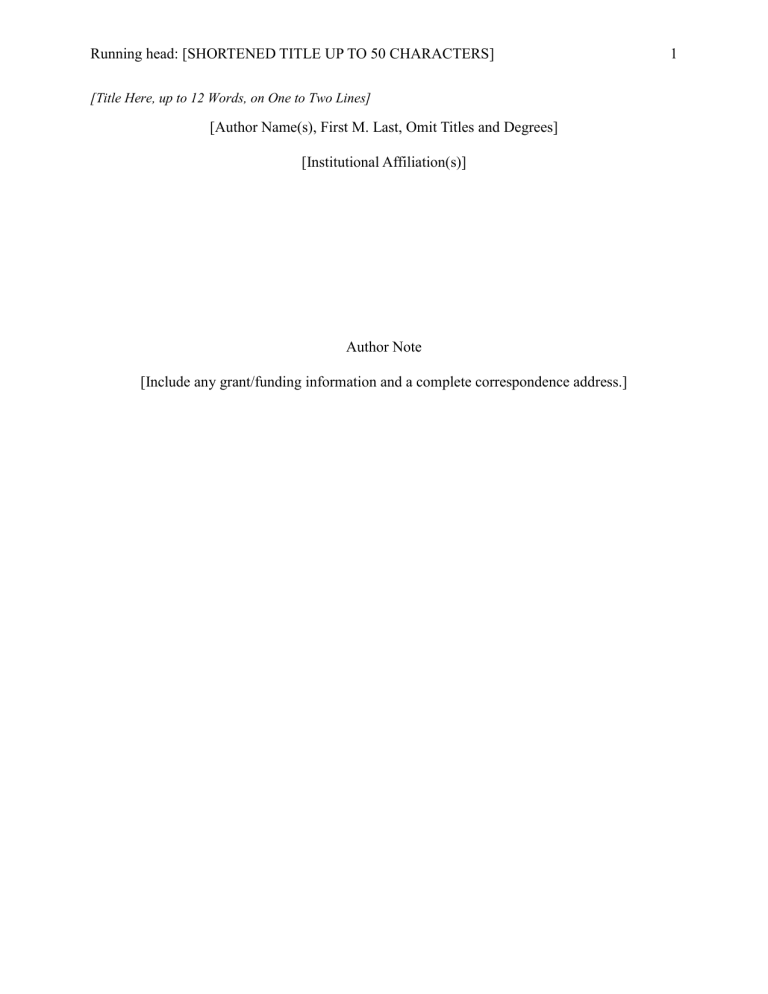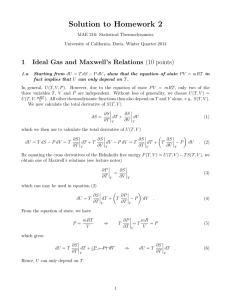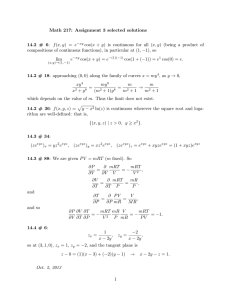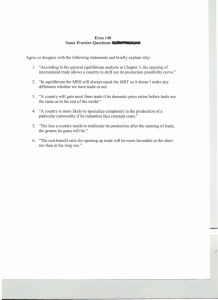Spatial Ability & Fluid Intelligence: Sex Differences & Correlations
advertisement

Running head: [SHORTENED TITLE UP TO 50 CHARACTERS] [Title Here, up to 12 Words, on One to Two Lines] [Author Name(s), First M. Last, Omit Titles and Degrees] [Institutional Affiliation(s)] Author Note [Include any grant/funding information and a complete correspondence address.] 1 [SHORTENED TITLE UP TO 50 CHARACTERS] Abstract [The abstract should be one paragraph of between 150 and 250 words. It is not indented. Section titles, such as the word Abstract above, are not considered headings so they don’t use bold heading format. Instead, use the Section Title style. This style automatically starts your section on a new page, so you don’t have to add page breaks. Note that all of the styles for this template are available on the Home tab of the ribbon, in the Styles gallery.] Keywords: [Click here to add keywords.] 2 [SHORTENED TITLE UP TO 50 CHARACTERS] 3 [Title Here, up to 12 Words, on One to Two Lines] Nature versus nurture has been the debate amongst academia for decades. Many academics debated biological sex differences regarding intelligence. Howard Gardner proposed eight intellectual abilities; these were musical-rhythmic, visual-spatial, verbal-linguistic, logicalmathematical, bodily-kinesthetic, interpersonal, intrapersonal, and naturalistic (Slavin, 2009). Questions such as whether men perform better at mathematics or women better at linguistics arose by researcherse. Cattell (1943) proposed that there are two forms of intelligence: crystallized and fluid. Crystallized intelligence was described as knowledge acquired through experience, which could be demonstrated through one’s vocabulary and general knowledge. However, Crystallized intelligence was not equated to long-term memory, though it was thought to be required to access it. Fluid intelligence was described as the capacity to reason, identify patterns and solve problems logically. It was not thought to require knowledge from the past. Spatial Abilities Spatial abilities are important for many everyday activities, including sports, navigation, academic success in science, technology, engineering and mathematics (STEM; Jansen & Lehmann, 2013; Labate, Pazzaglia, & Hegarty, 2014; Lubinski, 2010). Spatial abilities are divided into two main dimensions with a 2 x 2 model proposed by Uttal, Miller, and Newcombe (2013). They are static-dynamic and intrinsic-extrinsic; there are four types of spatial subabilities after combining the dimensions. Static-intrinsic involves the ability to perceive objects in complex shapes, while static-extrinsic is the understanding of abstract spatial principles. Dynamic-extrinsic is visualizing objects that occupy different locations in space, such as in perspective-taking tasks. Dynamic-intrinsic involves mentally transforming objects, such as mental rotation tasks that involve perceiving and rotating 2D or 3D objects (Scheer, Mattioni, & [SHORTENED TITLE UP TO 50 CHARACTERS] 4 Jansen, 2018). Commonly, it requires one to perceive 3D objects with a 2D drawing in a mental rotation test (MRT). MRT In an MRT, the participant is to compare a base-image of an object with other images. Only one image has the same object but rotated on an axis, while others are mirrored or similar images of the object to confuse the participant (Shepard & Metzler, 1971). The researcher judges the participant’s accuracy and time to distinguish the images. On average, men performed better than women (Linn & Petersen, 1985; Voyer & Voyer, 1995). However, a recent study of MRT that used eye-tracking methods and electroencephalography (EEG) behavioral analysis showed there were no differences in reaction time nor in the accuracy rate between men and women (Scheer et al., 2018). However, a crucial limitation of this study was the small sample of participants: 15 men and 15 women. A larger sample size was needed to for the findings to be more convincing. Nonetheless, Scheer et al.’s study indicated that men tended to use a holistic strategy and women a piecemeal strategy while performing the MRT. Thus, this finding shows there are differences between sex in processing spatial tasks. Fluid Intelligence Cattell (1943) described fluid intelligence as the ability to discriminate and perceive relations between any new or old fundaments, such as lines, dots, patterns and shapes. It is also the ability to recognize patterns and provide solutions through inductive and deductive reasoning. During his research with children’s intelligence tests, Cattell discovered that fluid intelligence does not require prior knowledge or experience. This ability peaks until adolescence and then deteriorates slowly. Cattell’s Culture Fair Intelligence Test (CCFIT) [SHORTENED TITLE UP TO 50 CHARACTERS] 5 Cattell developed the CCFIT to eliminate social, cultural and environmental factors. The test consists of non-verbal visual puzzles. It requires participants to solve mazes, copy symbols, identify sequences and fill in the blanks for the missing images (Domino & Domino, 2006). A study found that men obtain higher intelligence quotient (IQ) scores than women (Halpern & Lamay, 2000). However, research has shown that there are no significant sex differences in CCFIT scores (Colom & García-López, 2002; Đapo & Kolenović,-Đapo, 2012; D. F. Halpern & Tan, 2001). That contrasts Halpern and Lamay’s research and a meta-analysis of 22 studies by Irwing and Lynn (2005) that shows men obtain higher IQ scores than women. Aim and Hypotheses Our research aims to measure and compare men and women’s MRT and CCFIT scores in an Australian sample. From the mentioned literature, we predict that (1) men will score higher than women in MRT, and (2) men and women will have no significant difference in CCFIT. Additionally, a study that consisted of exclusively women participants found no correlation between MRT and CCFIT scores (Meneghetti, Cardillo, Mammarella, & Caviola, 2017). We aim to further Meneghetti et al.’s study and conduct it with men and women. Hence, (3) we predict there will be no correlation between MRT and CCFIT scores. Method Participants We used the Horlin (2018) dataset made available by a researcher at the School of Psychology, University of Glasgow. This dataset consisted of 205 participants’ information. There were 32 men, 107 women and 66 unspecified (mean±SD; men, 22±2 year; women 21±3 year). Data of participants who had missing information would be removed from this study, such as sex, CCFIT [SHORTENED TITLE UP TO 50 CHARACTERS] 6 scores or MRT scores. 120 participants were included from the initial pool (26 men and 94 women). No other demographics measures were used. Measures The participants in the Horlin (2018) dataset took the MRT test that consists of two 10-item sessions with three minutes for each section (Parsons et al., 2004). Each item presents four threedimensional target drawings of an arrangement of blocks and a reference-drawing. Participants were asked to select the two alternatives, which presented the same arrangement of blocks as the reference-drawing but in a randomly rotated manner. Participants could score 2 points for both correct answers, 1 point for one correct answer with the other not selected, or 0 points for either one or both incorrect answers. The sum of the scores from each item is the total score, which ranges from 0 to 40. The same participants also took the subtest-3 in the CCFIT test, this consisted of 96 questions and each question is scored differently (Domino & Domino, 2006). CCFIT has a standard deviation of 24, main bell curve range of 85-115 and the average range is 76-124. This is different to most IQ tests which use a standard deviation of 15 that has a median of 100 (Essa et al., 2016). Preparations and Assumptions Four assumptions were made prior to receiving the Horlin (2018) dataset. 1) The data collected are interval/ratio, 2) the data collected are independent, 3) the data are normally distributed, and 4) there is homogeneity of variance between the groups. We decided that if the data fails assumptions one and two, we will stop this study as the data would not be valid or reliable. If the data fails assumption three, we will examine the histogram but continue the study. If the data [SHORTENED TITLE UP TO 50 CHARACTERS] 7 fails assumption four, we will conduct a Welch t-test. Additionally, if there are any missing data from the Horlin (2018) dataset, these participants will be removed from the study. Statistical Analysis Since there were no time-of-completion data for either tests in the dataset, there will be no comparisons for reaction time. Descriptive Statistics This study will calculate the following descriptive statistics, grouped by the factor of sex, for MRT and CCFIT scores: mean, standard deviation, maximum, minimum, median, degrees of freedom, Cohen’s d, p-value, and t-value. Two histograms and violin-box plots for MRT and CCFIT will be produced for visualizing distribution. Inferential Statistics This study will carry out two t-test calculations for MRT and CCFIT for men versus women to compare their mean scores and significance. Additionally, this study will carry out Pearson’s correlation test between MRT and CCFIT scores to examine their relationship. A linear regression plot will be produced for the relation between MRT and CCFIT scores. Software Used All calculations will be carried out in R.studio using the following packages: “tidyverse”, “broom” and “ggpubr”. Results Pre-registration All hypotheses, descriptive, and inferential analyses were pre-registered except for hypothesis (2) and t-test for CCFIT (see Appendix B). Assumptions [SHORTENED TITLE UP TO 50 CHARACTERS] The Horlin (2018) dataset is interval data and each sample are independent of others. As illustrated in Figure 1, 2, 3 and 4, the data is normally distributed. The Levene’s test (see Appendix A) showed that the data does not have homogeneity of variance between groups. Hence, Welch t-test was used in this study. Figure 1. The distribution of participants’ total score of CCFIT. 8 [SHORTENED TITLE UP TO 50 CHARACTERS] Figure 2. The distribution of participants’ total score of MRT. Figure 3. Violin boxplot of men and women’s total scores for CCFIT. 9 [SHORTENED TITLE UP TO 50 CHARACTERS] 10 Figure 4. Violin boxplot of men and women’s total scores for MRT. The mean score of men was significantly greater than the mean score of women in MRT (Table 1). This supports hypothesis 1 which stated that men would perform better than women in MRT. The mean scores between men and women showed no significant difference in CCFIT (Table 1). This supports hypothesis 2 which stated that there would be no significant difference in men and women’s performance in CCFIT. Interesting to note that the maximum and minimum scores for men and women in both tests were similar and their maximum scores for both tests were equal. Table 1 Significance report between men (n = 26) and women (n = 94) for MRT and CCFIT Test M SD df t p Men Women Men Women MRT 17.15 12.41 5.30 42.2 4.74 < .001* 4.96 CCFIT 32.27 30.94 4.65 4.11 36.5 1.33 0.19** *Note: The means for men and women in MRT are significant (p < .05). ** Note: The means for men and women in CCFIT are insignificant (p > .05). d 0.92 0.30 [SHORTENED TITLE UP TO 50 CHARACTERS] 11 Table 2 The median, maximum and minimum scores for MRT and CCFIT Test MRT CCFIT Median Men Women 17.5 12 33 31 Maximum Men Women 24 24 39 39 Minimum Men Women 8 2 18 22 We found a medium, significant, positive correlation between MRT (M = 13.44, SD = 5.57) and CCFIT (M = 31.23, SD = 4.25, r(120) = 0.41, p < .001, see Table 3 and Figure 5, Borenstein & Cohen, 1988). This rejects hypothesis 3 which stated that there will be no correlation between MRT and CCFIT scores. Table 3 Pearson’s correlations among MRT and CCFIT MRT CCFIT MRT 0.41* CCFIT 0.41* *Note: Correlation is medium significant. p < .001 < .001 [SHORTENED TITLE UP TO 50 CHARACTERS] 12 Figure 5. Scatter plot showing correlation and linear regression between MRT scores and CCFIT scores. Discussion The results show that men did better than women in MRT and had no significant difference in CCFIT between men and women. The effect size is large and small for MRT and CCFIT t-tests, respectively. Both of these results agree with previous research (Colom & GarcíaLópez, 2002; Đapo & Kolenović,-Đapo, 2012; D. F. Halpern & Tan, 2001; Linn & Petersen, 1985; Voyer & Voyer, 1995). There is a medium correlation between MRT and CCFIT scores which was unexpected which contrasts previous study by Meneghetti et al. (2017). A possible explanation to the contrast is the study by Meneghetti et al. consisted of only women. The lack of data of men might cause the authors to have type II error. A type II error occurs when the null hypothesis is false but the researchers failed to reject it (Shermer, 2002). [SHORTENED TITLE UP TO 50 CHARACTERS] 13 Previous research show that there is no significant sex differences in CCFIT scores (Colom & García-López, 2002; Đapo & Kolenović,-Đapo, 2012; D. F. Halpern & Tan, 2001). However, that does not imply individuals with better spatial abilities would not have an advantage in CCFIT. This indicates, though not strong since the correlation is medium, that participants with high spatial abilities can be benefited in CCFIT. Both groups managed to achieve the same highest scores for MRT. This indicates that, though the mean is significantly different in MRT, the statistics does not reflect the entirety of the individual abilities. Scheer et al.’s (2018) study stated the different strategies used by men and women in MRT; men tend to use a holistic strategy and women use a piecemeal strategy. This indicates that there is no best strategy to solve the CCFIT questions as there are no significant sex differences. It is possible that we had overestimated the sex differences in MRT and underestimated the similarities between MRT and CCFIT in the hypothesizing stage. There are many limitations in this study. First, the amount of available data (n=120) is small and the lack of data of men might have affected the results. Second, the sample data was collected from Australia. This study cannot draw cultural inferences due to the lack of cross cultured data. Third, the participants’ reaction time and time of completion of both tests were not available. The difference in strategies between men and women might achieve similar results in both tests. However, one strategy may complete the tests with a shorter amount of time than the other. Fourth, the participant’s background information, such as interests, upbringing, strengths, weaknesses and academic performance were not provided. This information may add more insight into the nature versus nurture aspect. Men and women have differences. However, individual differences also contribute to difference performances. Nonetheless, it is improbable to factor individual differences into this [SHORTENED TITLE UP TO 50 CHARACTERS] 14 study due to the limitations. It is crucial to note that CCFIT scores had no sex difference. CCFIT may be a more reliable IQ test. Additionally, the sex differences in MRT scores were small, which does not affect MRT’s utility. The relationship between special abilities and fluid intelligence should be further explored. The eight intelligence abilities (Slavin, 2009) may be more interconnected than researchers had assumed. Future studies should collect data from different cultures, record the reaction and completion time and collect background information to gain a wider perspective in this area. [SHORTENED TITLE UP TO 50 CHARACTERS] References Last Name, F. M. (Year). Article Title. Journal Title, Pages From - To. Last Name, F. M. (Year). Book Title. City Name: Publisher Name. 15 [SHORTENED TITLE UP TO 50 CHARACTERS] 16 Footnotes 1 [Add footnotes, if any, on their own page following references. For APA formatting requirements, it’s easy to just type your own footnote references and notes. To format a footnote reference, select the number and then, on the Home tab, in the Styles gallery, click Footnote Reference. The body of a footnote, such as this example, uses the Normal text style. (Note: If you delete this sample footnote, don’t forget to delete its in-text reference as well. That’s at the end of the sample Heading 2 paragraph on the first page of body content in this template.)] [SHORTENED TITLE UP TO 50 CHARACTERS] 17 Tables Table 1 [Table Title] Column Head Row Head Row Head Row Head Row Head Row Head Row Head Column Head 123 456 789 123 456 789 Column Head 123 456 789 123 456 789 Column Head 123 456 789 123 456 789 Column Head 123 456 789 123 456 789 Note: [Place all tables for your paper in a tables section, following references (and, if applicable, footnotes). Start a new page for each table, include a table number and table title for each, as shown on this page. All explanatory text appears in a table note that follows the table, such as this one. Use the Table/Figure style, available on the Home tab, in the Styles gallery, to get the spacing between table and note. Tables in APA format can use single or 1.5 line spacing. Include a heading for every row and column, even if the content seems obvious. A default table style has been setup for this template that fits APA guidelines. To insert a table, on the Insert tab, click Table.] [SHORTENED TITLE UP TO 50 CHARACTERS] 18 Figures title: 6 5 4 3 2 1 0 Category 1 Category 2 Series 1 Category 3 Series 2 Category 4 Series 3 Figure 1. [Include all figures in their own section, following references (and footnotes and tables, if applicable). Include a numbered caption for each figure. Use the Table/Figure style for easy spacing between figure and caption.] For more information about all elements of APA formatting, please consult the APA Style Manual, 6th Edition.


